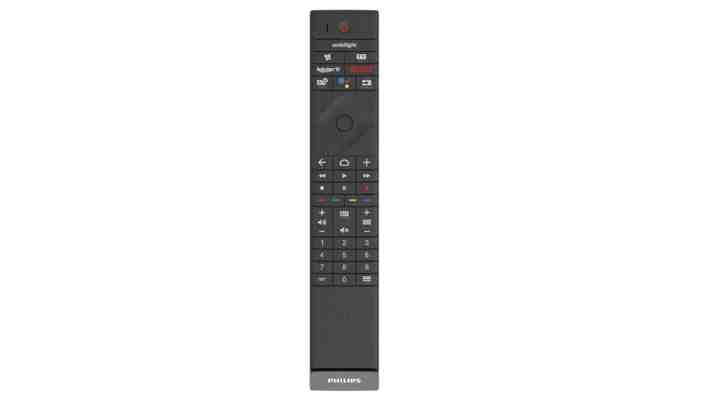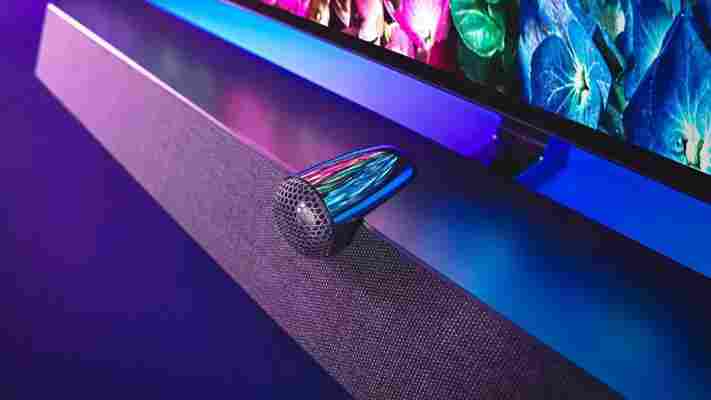When there are so many fantastic OLEDs on the market it can be hard for one to stand out from the self-emissive crowd. That’s not the case for the Philips OLED+935, however, thanks to two very special features. Firstly, there’s its four-sided Ambilight, Philips’ immersive proprietary bias lighting system. Secondly, it has a premium built-in Bowers & Wilkins soundbar that gives it a luxurious sound and unique look that no other TV can match, OLED or otherwise.
Simply put, it’s the best sounding TV of the year. And it just so happens that its HDR performance is damn near unbeatable too.
Philips OLED+935 review: Key specifications
| Screen sizes available: | 48in 48OLED935/12, 55in 55OLED935/12, 65in 65OLED935/12 |
| Panel type and backlight: | OLED |
| Resolution: | 3,840 x 2,160 |
| Refresh rate: | 120Hz |
| HDR formats supported: | HDR 10, HDR 10+, HLG, Dolby Vision |
| Audio enhancement: | Dolby Atmos |
| HDMI inputs: | 4 x HDMI 2.0b |
| Input lag: | 37ms |
| Gaming features: | ALLM |
| Streaming services: | Netflix, Amazon Prime Video, Disney+, Google Play Movies, YouTube, Freeview Play and more |
| Tuners: | DVB-T/T2/T2-HD/C/S/S2 |
| Wireless connectivity: | Wi-Fi 802.11ac, Bluetooth 4.2 |
| Smart platform: | Android TV 9 (Pie) |
Philips OLED+935 review: What you need to know
The OLED+935 is the flagship 4K model from Philips in 2020, coming in above OLED models such as the Philips 805 that we tested earlier in the year. OLED+ is Philips’ branding for OLED TVs that have built-in Bowers & Wilkins speaker systems – the 935 is the third collaboration with the award-winning British audio brand.
Its OLED panel has a 4K/UHD (3,840 x 2,160) resolution and a refresh rate of 120Hz. Unlike some high-end TVs, it can’t display a 4K 120Hz signal, which is a crucial part of the next-gen gaming experience on consoles such as the Xbox Series X and PlayStation 5. On the bright side, the OLED+935 has an extremely high peak luminance, resulting in a superb HDR performance, and all the key formats are supported: HDR 10, HDR 10+, Hybrid Log-Gamma (HLG) and Dolby Vision.
For this review, we tested the 55in variant of the OLED+935, but it’s also available in 48in and 65in screen sizes. Like other Philips TVs on the market, the 935 runs Android TV 9 Pie, which means it carries all of the free and paid-for streaming platforms you’ll need. Google Assistant voice search comes built-in and there’s also support for any Amazon Alexa devices you may have at home.
Buy now from Currys
Philips OLED+935 review: Price and competition
Philips priced its OLEDs keenly in 2020 and the 935 is no exception. Our 55in model is available in the UK for around £1,699 from Currys PC World – seemingly the only retailer that stocks it at the moment. The 48in model is cheaper at £1,499 , while the 65in unit will set you back £2,399 .
The closest competitor here is the LG CX, which was our favourite OLED of 2020. Since the time of our five-star Best Buy review , it’s come steadily down in price: you can now find the 55in model for as little as £1,299 , a hefty £300 less than the 935 on test here and amazing value considering the CX’s unrivaled next-gen gaming support. Ths CX has four HDMI 2.1 ports that can handle VRR, 4K at 120Hz and ALLM, and its input lag is the lowest of any TV we’ve ever tested. Image quality is spectacular too, although its speakers are no match for the 935’s speaker bar.
But the best-value OLED of all? It’s another Philips. With £300 off its initial launch price, the stunning Philips 805 55in is available from only £1,199. Overall image quality is comparable with the OLED+935, making it a great choice for movie nights and TV marathons, although it doesn’t get quite as bright. Its Ambilight implementation is only three-sided, however, and, of course, it doesn’t have the speaker bar, either. Then again, its affordability means you could purchase the 805 along with a high-quality soundbar and still spend less than you would on a 935.
Philips OLED+935 review: Design and features

The bezels surrounding the 55in screen are incredibly thin, while the self-emissive nature of OLED means that the panel doesn’t require any LED backlighting, resulting in a super-sleek and slim design. Everything rests on that elegant Bowers & Wilkins speaker bar, which doubles up as a central pedestal stand. The rectangular speaker bar has a grey finish with a wraparound fabric, and the distinctive tweeter-on-top design is a particularly eye-catching feature – at first glance, it does kind of look like a webcam, though.
All of the 935’s connections are situated to the left rear of the display and they include four HDMI 2.0b ports. The only HDMI 2.1 feature here is Auto Low Latency Mode (ALLM), a feature that activates the TV’s low-latency Game Mode when compatible consoles (such as the PlayStation 5 and Xbox Series X) are connected.
The back of the TV also houses Philips’ four-sided Ambilight technology. This comprises four multicoloured LED strips that light up the rear wall. This isn’t just a novelty, though, as Ambilight adjusts the colour and brightness of the LED strips to match the onscreen action. When watching in a dark room, this kind of “bias lighting” has the added bonus of reducing eye fatigue. You can adjust Ambilight to your taste and, if you don’t enjoy the more dynamic lighting, you can set it to a static warm white, which is what we personally prefer for everyday viewing.

This TV comes supplied with Philips’ latest premium remote, a sleek, angular effort with backlit keys and a leather-coated back. The buttons sit flush to the face of the remote, which looks smart but does result in a lot more accidental key presses than we’ve experienced with other remotes from rival manufacturers. Towards the top of the remote, there are quick launch keys for Netflix, Google Assistant voice search and Ambilight controls.
Like the Philips 805 we tested in 2020, the 935 runs the latest version of Google’s smart TV platform, Android TV 9 Pie. The UI is powered by a lacklustre MediaTek MT5887 SoC backed by 2.5GB of RAM so the user experience isn’t as speedy as we’d like, especially compared to Sony’s recent Android TVs, but it gets the job done.
All the key streaming platforms are on offer here, including Netflix, Amazon Prime Video and Disney+, in addition to the free UK catch-up apps courtesy of Freeview Play. As mentioned, Google Assistant is on hand to carry out voice commands and the platform also works in tandem with Alexa smart home devices.
Philips OLED+935 review: Speaker bar
The standout feature of the 935 is definitely the custom Bowers & Wilkins speaker bar and, if you’re an audio buff, it may be the deciding factor in choosing the 935 over any of its rivals. The left, centre and right channels pump sound out across the entire room, filling the space with a surprisingly wide and impactful soundstage to create a truly immersive surround sound effect. There are limits to what the speaker bar can do, however, and if you sit too far away you’ll lose some of that immediacy.

Clarity is outstanding, letting us hear the subtlest sound effects that would otherwise be lost by most built-in TV speakers. Without a doubt, the 935 delivers the best sound quality of any TV we tested in 2020. Bass power is above average too but for low-frequency junkies after some serious wall-shaking punch, Philips provides an analogue subwoofer output.
Buy now from Currys
Philips OLED+935 review: Image quality
The 935 uses a 2020 WRG OLED panel from LG Display and, being an OLED, its black levels and contrast ratio are inherently superior to any LCD TV on the market. The vibrant colours and wide viewing angles impress too, although these qualities aren’t really any different to other OLEDs out there. One difference we did find is that the 935 applies more near-black dithering than other rival OLEDs, meaning dark scenes have more noise. That said, in most real-world content it’s not an issue.
Thankfully, colour accuracy in SDR mode is excellent, especially after calibration. We measured an average Delta E of one, and not a single colour patch exceeded the humanly perceptible Delta E threshold of three. For a TV in this price range, that’s as accurate as you’re going to get. Across the board, the 935 has a natural-looking and cinematic colour palette for all colours and skin tones.
Motion handling on Philips TVs has seen an improvement this year with the addition of two new motion settings, Pure Cinema and Movie. Activating Pure Cinema will apply 5:5 pulldown to accurately reproduce 24fps films without any noticeable telecine judder, while Movie adds a small dose of interpolation to smooth out the inherent judder in 24p content. Sticklers that we are, we can still detect some soap opera effect (SOE) in Movie mode so, if that bothers you, Pure Cinema is the best option.
Unlike rival OLEDs from LG, Panasonic and Sony this year, the Philips 935 doesn't offer black frame insertion (BFI) technology. Nevertheless, its motion interpolation is up there with the very best, improving motion clarity without incurring frame drops or microstutter.
The 935’s brightness uniformity is nigh-on impeccable too, exhibiting no signs of banding or colour tinting on full-field, single-colour slides. This is great news no matter what you watch, although it’s especially handy if you watch a lot of sports or like your gaming. Dark uniformity testing on our review sample did show up some vertical streaking and side vignetting, but this is perfectly typical of consumer OLED models.
As for video processing, Philips went a little overboard. Upscaling of video to 4K is much more aggressive than we’ve seen from other TV manufacturers, meaning SD content looks sharper yet noisier, with lots of ringing artefacts. However, the 935 is able to correctly detect and process 3:2 and 2:2 cadences in film-based interlaced material, for example from the internal Freeview tuner.
Philips OLED+935 review: HDR performance
As for high dynamic range, the 935 delivers the most impactful experience of any OLED in its price range. We measured a peak brightness of 711cd/m ² at full-field and 137cd/m ² on a 10% window, making it the second-brightest OLED of 2020 (behind only the £4,000 Panasonic HZ2000).
The palette of colours at its disposal is top-notch too, with the Philips covering 98% of the DCI-P3 colour space (the colour space used for digital film distribution) and 72% of the Rec. 2020 range.
As a result, HDR movies and TV shows look vibrant and refined and, when bordered by the inky black letterbox bars made possible by OLED’s pixel-level control, the images leap right out and grab you. That exceptionally high brightness gives everything an added sparkle, and this is especially noticeable when viewing in a properly darkened room.

We did notice some minor posterisation during 10-bit HDR playback (for example, in the red skies of The Martian) but this can be attenuated by engaging the Noise Reduction and MPEG Artefact Reduction settings, which in turn activates the TV’s AI Smart Bit Enhancement 2.0 decontouring filter. However, with all of these noise reduction settings turned on some finer details are inevitably scrubbed away.
Every HDR format is supported on the 935, from HDR 10 and HDR1 0+ to Dolby Vision and HLG. Not all high-end TVs give you this universal HDR support – LG models lack HDR 10+, and Samsung doesn’t support Dolby Vision – so the Philips is an ideal choice if you want to enjoy HDR from every source possible. This model uses the TV-led iteration of Dolby Vision, which is generally superior to the low-latency variant of Dolby Vision implemented on rival OLEDs from Sony.
Buy now from Currys
Philips OLED+935 review: Gaming
Disappointingly, the 935 isn’t well future-proofed when it comes to gaming. The only HDMI 2.1 features supported by its HDMI 2.0b inputs is ALLM, which has to first be enabled in the user menu. Without variable refresh rate (VRR) and 4K at 120Hz, the 935 will be shunned by owners of next-gen consoles such as the PlayStation 5 and Xbox Series X.
Even with the low-latency Game Mode enabled, the 935’s response times aren’t up to scratch. We measured an input lag of 37ms on a 60Hz video signal, a result that’s well behind the competition and far too sluggish for hardcore competitive gamers.
The 935 does at least have one trick up its sleeve in the form of anti-burn-in measures. As well as pixel shifting and screensavers, the 935 benefits from Philip’s own unique algorithm for detecting logos and other static elements (such as in-game HUDs) and dimming them down selectively without affecting the brightness of the rest of the picture. With this combination of preventative measures, the 935 is better guarded against burn-in than most OLEDs.
Philips OLED+935 review: Verdict
Owing to its custom Bowers & Wilkins speaker bar, the Philips OLED+935 is easily the best-sounding TV we tested in 2020 and – paired with the OLED panel’s lucid, hyper-accurate picture quality – it’s a formidable package indeed. Factor in the exceptionally high brightness and four-sided Ambilight, and the 935 provides unmatched levels of immersion for film and TV viewing.
It falls down on the next-gen gaming front so, if that’s your main interest, the 935 isn’t for you. PlayStation 5 and Xbox Series X owners will be better served by the LG CX 55in . But for those of you who play games rarely or not at all, the 935 55in is the best OLED TV you can buy that doesn’t cost upwards of £2,000.
